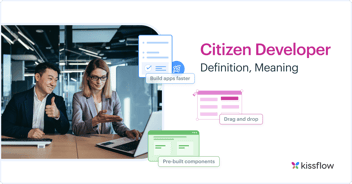
- >
- Citizen Development >
- How Citizen Development Helps Build Technology Outside of IT
How Citizen Development Helps Build Technology Outside of IT
Team Kissflow
Updated on 23 Apr 2025 • 6 min read
Organizational initiatives to step up their digital transformation game have put more pressure on IT teams to deliver new tech demands. While IT professionals have always been tasked with building new applications, increased demand for new solutions has got them more overwhelmed now than ever. Also, professional developers with the knowledge and expertise to build applications from scratch are quite expensive and in short supply. This presents a grave challenge to many organizations.
That’s where citizen development comes in.
Citizen development empowers non-developers to build solutions faster and solve business problems with greater ease and efficiency using low-code or no-code platform. They don’t have to wait for pro developers to write code and develop applications. Because they are experts in their fields, they use existing resources to build tech solutions for their own use and others. McKinsey reports that organizations that empower citizen developers score 33%[1] higher on innovation.
Burnt-out IT causes acute operational friction
An ever-increasing IT ticket backlog and multiple software projects have overburdened IT departments. When IT departments cannot meet the growing demand for enterprise citizen developer apps, work stalls, and everyone gets frustrated. Also, the growing shortage of skilled professional developers will push organizations to spend more money on app development in the coming years.
Enabling your non-IT workforce to be citizen developers can take the pressure off IT, lowers the cost of app development, and speeds up the deployment cycle. They respond flexibly to varying business requirements, bringing unique insight and expertise to the future of app development.
- By 2024, 80%[2] of non-developers will create IT products and services. They will take the load off IT teams, allowing them to focus on more complex projects.
- 80%[3] of companies with citizen development programs have freed up their IT teams to focus on higher-level tasks.
Learn more: How Citizen Development Unites Business and IT
Why do businesses hesitate to build tech solutions outside IT?
Although most organizations envision being digitally progressive, they have their reservations for a variety of reasons.
- Enterprise standards for application development and security may be compromised.
- Non-tech staff may have inadequate expertise to create innovative and complex technology products.
- Rogue shadow IT projects may not follow corporate guidelines and policies.
- Apps may get deployed before they're approved or go through a testing process.
- Inconsistent and questionable app quality across the organization.
- Poorly designed applications may not integrate with enterprise data and systems.
How citizen development makes building apps outside IT safe and secure
The citizen development framework allows business users with little to no coding expertise to build custom applications for themselves or others using intuitive tools sanctioned by IT. The emergence of citizen development has helped these users create applications outside IT safely and securely by:
Getting support from IT
Citizen development eliminates shadow IT, which can result in non-compliant applications, ineffective working practices, and security risks. Shadow IT refers to the use of unauthorized apps and tools to accomplish tasks in the workspace.
LCNC and citizen development offer straightforward UIs and simple automation, enabling business users to follow best practices and collaborate with IT.
Boosting collaboration
Shadow IT happens when there’s no collaboration between IT and business users. Low-code/no-code platforms don’t eliminate the need for pro developers, but instead, they allow them to collaborate with non-developers. Citizen development increases a company’s agility and responds quickly to market requirements and changes in customer behavior.
By encouraging your citizen developers to partner with IT, you can clearly outline responsibilities for the two sectors and ensure that value-added experiences are delivered to both employees and customers.
Finding the right low-code, no-code platforms
LCNC platforms allow citizen developers to develop applications quickly. Using drag-and-drop functions and pre-built templates, citizen developers can build apps in less than two weeks. But it’s important to choose the right citizen development platform for your company.
Business unit leaders and IT leaders can work together to pick a platform that easily integrates into the organization’s existing IT infrastructure.
Learn more: How Low Code Apps Empower Citizen Developers
Establishing a governance plan
Citizen developers are mostly employees looking to solve work-related problems they—or their colleagues—face every day. Because they are not pro developers, they need governance to build applications that meet enterprise standards and adhere to regulations.
A citizen developer governance plan ensures that IT assistance is well-defined and data security best practices are followed. The plan should cover:
- Requirements for admitting projects into the citizen developer program
- Security and compliance requirements for every project accepted
- Standard workflow protocols: testing, validation, deployment, and integration
-
When IT involvement is required
Learn more: Crucial Best Practices for Building Citizen-Made Applications

The No-Code Approach to Unlock Citizen Development Excellence
Thank you for downloading!
3 Pivotal Steps to Mitigate Security Risks
Step 1: Standardizing LCNC tools
- Standardize your tool sets: You cannot use all the tools available in the market and don’t flood your IT environment.
- Establish Standard Operating Procedures (SOPs): You should establish SOPs for how citizen developers must use the tools.
- Ensure expert-driven due diligence: There should be expert-driven due diligence to identify the right set of tools that solve your problems and suit your use case. It could be a low-code tool/platform or a no-code tool/platform.
Step 2: Training citizen developers
You can’t assume that citizen developers will voluntarily participate and solve the problems they have. You need to initiate an LCNC training program that handholds the citizen developers for a few weeks or months so that citizen developers can develop the best apps.
Step 3: Mentoring citizen developers
After following the two steps, you can’t let citizen developers get into the wild. You should have a mentorship program within so that they can reach out to the tech team, discuss, and make sure they are on the right track.
Training citizen developers
Low-code platform allow citizen developers to be more involved in digital transformation. But to do their job well, they need proper training. Choose a vendor that offers training as part of the package. Citizen developers should understand the platform’s functionalities and know how to turn their ideas into useful applications before they get started.
Learn more: 10 Must Know Tips To Kickstart Your Citizen Development Journey
How IT and citizen developers solve organizational problems
Citizen developers are individuals who create new functional applications that fit into their digital environments without formal programming training or written code. They’re members of business units, empowered problem-solvers with the drive and determination to use new tools and find solutions for their unique problems. Citizen development:
1. Inspires innovation and increases autonomy
With increasing digital literacy, more employees can become citizen developers and customize diverse tech features to build the digital solutions they need. Empowering non-IT employees to engage in the app development process substantially improves their digital experience. It helps them better understand tech capabilities and limitations, encouraging company-wide innovation, digital agility, and accelerating business sustainability.
It also increases job satisfaction and strengthens employees’ sense of autonomy, enabling them to meet their needs without delays.
2. Improves efficiency and productivity development
Matching the fast digital transformation pace and staying relevant in customers’ eyes requires rapid, continual progress. Democratizing valuable development capabilities to citizen developers helps your company distribute the task of building powerful, creative apps across a wider group of employees.
Adopting low-code/no-code tools can increase efficiency by 50%-90% and consume 70% fewer resources. They also promote resource sharing, enhancing organizational transparency.
Learn more: How to Supercharge Productivity and Innovation with Citizen Development
3. Encourages faster digital transformation
Citizen development can fast-track your digital transformation goals, helping your company release products and services quicker. Compared to conventional systems, low-code/no-code solutions accelerate app development by up to 10 times. When IT teams cannot deliver tech solutions fast enough, forward-thinking employees in 62% of businesses get frustrated.
Also, slow response times hinder the achievement of key business strategic goals. Tapping into your entire workforce, rather than just IT, makes it much easier and faster to digitize your company.
Learn more: How Does Citizen Development Facilitate Digital Transformation?
4. Reduces IT-related costs
Citizen development increases employees’ technical understanding, helping them maximize current resources and build enterprise citizen developer apps with existing tools. Citizen developers decrease software maintenance and licensing expenses and save the money you’d have spent purchasing third-party applications or hiring professional developers. Low-code/no-code platforms are more affordable than skilled developers who charge upwards of $300 per hour.
5. Address the shortage of developers
To combat the growing shortage of developers, your company can leverage employees' increasing digital dexterity in citizen development programs. With the right citizen developer tools, citizen development and IT teams bridge the gap between software developer supply and demand, meeting your organizational need for apps. LCNC and citizen development inspire innovation and help employees design new apps easily.
Citizen development programs upskill employees so they don't have to rely on IT help to solve simple tech issues. IT departments can then focus on more mission-critical projects.
Learn more: How Citizen Development Helps Build Technology Outside of IT
How citizen development revolution impacts business
Citizen development will change the future of business in the following ways:
- Increase collaboration between departments: Low-code/no-code platforms ensure there are no disjointed departments, promoting collaboration between IT and other departments. Citizen development will continue to improve organizational performance and accelerate business stability, ensuring app development is aligned with company goals and that apps offer value to end-users.
- Lower costs: Pro developers are in high demand, and you’ll have to pay a lump sum amount to hire one. However, with citizen development, organizations can empower employees to share tools and resources, minimizing costs. Low-code, no-code platforms will continue to optimize costs by reducing the need for professional developers. They are user-friendly and require less IT input.
- Speedier application development: LCNC platforms have simple, intuitive user interfaces with prebuilt templates and drag-and-drop features that accelerate app development by 10 times. With them, employees will do more in less time.
- Increased productivity and efficiency: Pro developers cannot solely handle the increasing new tech demand. They need the help of citizen developers who will free up pro developers, allowing them to focus on more crucial issues like infrastructure modernization.
- Higher employee motivation: Empowering employees to become citizen developers increases job autonomy and satisfaction because they create solutions based on business needs. Citizen development programs will continue to equip non-developers with the tech skills they need to create enterprise apps and advance their technical know-how as per the statistics.
Get started with citizen development today
The citizen development revolution has taken over the corporate world and is here to stay. If you want your company to be competitive and thrive in an ever-changing environment, start a citizen development program. Streamline app development, reduce the burden on IT, and increase operational efficiency in no time.
Kissflow's citizen development platform can help your organization launch an effective citizen development program and work towards its digital transformation goals. Our easy-to-use visual interface and pre-built modules do away with raw coding. Build your tech outside IT safely and securely and align app development with user needs.
Related Articles











